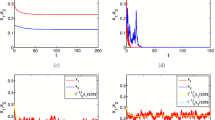Abstract
This paper considers environmental–economic models of optimal harvesting, given by impulsive differential equations, which depend on random parameters. We assume that lengths of intervals \({{\theta }_{k}}\) between the moments of impulses \({{\tau }_{k}}\) are random variables and the sizes of impulse influence depend on random parameters \({{{v}}_{k}},\)\(k = 1,2, \ldots \) One example of such objects is an impulsive equation that simulates dynamics of the population subject to harvesting. In the absence of harvesting, the population development is described by the differential equation \(\dot {x} = g(x),\) and in time points \({{\tau }_{k}}\) some random share of resource \({{{v}}_{k}},\)\(k = 1,2, \ldots \) is taken from the population. We can control the gathering process so that to stop harvesting when its share will appear big enough to save the biggest possible remaining resource to increase the size of the next gathering. Let the equation \(\dot {x} = g(x)\) have an asymptotic stable solution \(\varphi (t) \equiv K,\) whose attraction region is the interval \(({{K}_{1}},{{K}_{2}}),\) where \(0 \leqslant {{K}_{1}} < K < {{K}_{2}}.\) We construct the control \(u = ({{u}_{1}}, \ldots ,{{u}_{k}}, \ldots ),\) which limits a share of the harvested resource at each moment of time \({{\tau }_{k}}\) so that the quantity of the remaining resource, since some moment \({{\tau }_{{{{k}_{0}}}}},\) would be not less than the given value \(x \in ({{K}_{1}},K).\) For any \(x \in ({{K}_{1}},K)\) the estimates of the average temporal benefit, valid with the probability of one, are obtained. It is shown that there is a unique \(x* \in ({{K}_{1}},K),\) at which the lower estimate reaches the greatest value. Thus, we described the way of population control at which the value of the average time profit can be lower estimated with the probability of one by the greatest number whenever possible.
Similar content being viewed by others
REFERENCES
Riznichenko, G.Yu., Lektsii po matematicheskim modelyam v biologii. Ch. 1 (Lectures on Mathematical Models in Biology. Part 1), Izhevsk, 2002.
Bainov, D.D., Population dynamics control in regard to minimizing the time necessary for the regeneration of a biomass taken away from the population, Appl. Math. Comput., 1990, vol. 39, no. 3, pp. 37–48.
Belyakov, A.O., Davydov, A.A., and Veliov, V.M., Optimal cyclic exploitation of renewable resources, J. Dyn. Control Syst., 2015, vol. 21, no. 3, pp. 475–494.
Belyakov, A.O. and Davydov, A.A., Efficiency optimization for the cyclic use of a renewable resource, Tr. Inst. Mat. Mekh. Ural. Otdel. Ross. Akad. Nauk, 2016, vol. 22, no. 2, pp. 38–46.
Aseev, S. and Manzoor, T., Optimal Growth, Renewable Resources and Sustainability, Laxenburg: International Institute for Applied Systems Analysis (IIASA), 2016.
Reed, W.J., Optimal escapement levels in stochastic and deterministic harvesting models, J. Environ. Econ. Manage., 1979, vol. 6, pp. 350–363.
Kapaun, U. and Quaas, M.F., Does the optimal size of a fish stock increase with environmental uncertainties?, Econ. Work. Pap., 2012, nos. 2012-09, pp. 1–40.
Clark, C. and Kirkwood, G., On uncertain renewable resource stocks: Optimal harvest policies and the value of stock surveys, J. Environ. Econ. Manage., 1986, pp. 235–244.
Reed, W.J. and Clarke, H.R., Harvest decisions and assert valuation for biological resources exhibiting size-dependent stochastic growth, Int. Econ. Rev., 1990, vol. 31, pp. 147–169.
Weitzman, M.L., Landing fees vs harvest quotas with uncertain fish stocks, J. Environ. Econ. Manage., 2002, vol. 43, pp. 325–338.
Rodina, L.I., Optimization of average time profit for a probability model of the population subject to a craft, Vestn. Udmurtsk. Univ.,Mat. Mekh. Komp’yut. Nauki, 2018, vol. 28, no. 1, pp. 48–58.
Rodina, L.I. and Khammadi, A.K., Statistical characteristics of attainability set of controllable systems with random coefficients, Russ. Math. (Izv. VUZov), 2014, vol. 58, no. 11, pp. 43–53.
Rodina, L.I. and Tyuteev, I.I., About asymptotical properties of solutions of difference equations with random parameters, Vestn. Udmurtsk. Univ.,Mat. Mekh. Komp. Nauki, 2016, vol. 26, no. 1, pp. 79–86.
Shiryaev, A.N., Veroyatnost’ (Probability), Moscow: Nauka, 1989.
Feller, V., An Introduction to Probability Theory and Its Applications, Wiley, 1968, vol. 2.
Filippov, A.F., Introduction to the Theory of Differential Equations, Editorial URSS, Moscow, 2004.
Chaplygin, S.A., Novyi metod priblizhennogo integrirovaniya differentsial’nykh uravnenii (The New Method for Approximate Integration of Differential Equations), Moscow–Leningrad: Gostekhizdat, 1950.
Funding
This work was supported by the Russian Foundation for Basic Research, project no. 16-01-00346-a.
Author information
Authors and Affiliations
Corresponding authors
Ethics declarations
The authors declare that they have no conflicts of interest.
Additional information
Translated by K. Lazarev
About this article
Cite this article
Rodina, L.I., Tyuteev, I.I. Estimating the Average Temporal Benefit in Probabilistic Environmental–Economic Models. Aut. Control Comp. Sci. 53, 730–737 (2019). https://doi.org/10.3103/S0146411619070174
Received:
Published:
Issue Date:
DOI: https://doi.org/10.3103/S0146411619070174



